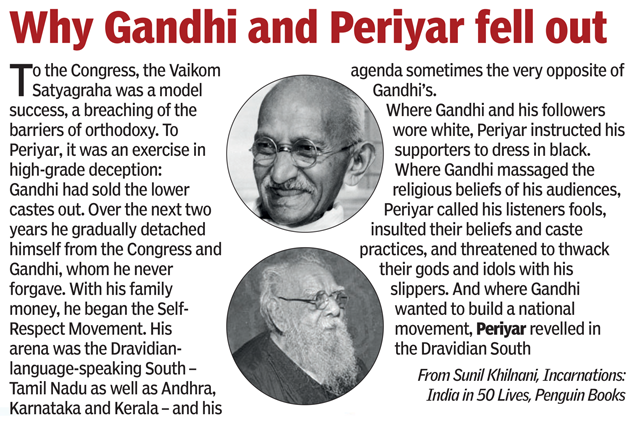
Gandhi@150: When Mahatma fought for Dalits temple entry in south India
NEW DELHI: Vaikom in Kottayam district of Kerala is a small town of about 25,000 people. Politically..
NEW DELHI: Vaikom in Kottayam district of Kerala is a small town of about 25,000 people. Politically, it is an assembly constituency reserved for Dalits. But a century ago, this was a place symbolic of upper-caste repression of the lower castes. In 1924-25, the town became the nerve centre of a massive socio-religious movement that threatened upper-caste hegemony over Hindu temples and challenged untouchability. And Mahatma Gandhi was central to it.
The Vaikom Satyagraha, as the movement is known, rose from the ashes of the Non-Cooperation Movement (1920-22), which was really the first nationwide political agitation against the British Raj fought under the institutional leadership of the Indian National Congress.
Vaikom was at the heart of a discriminatory practice that prohibited the entry of avarnas (lower castes or untouchables) into its famous Shiva temple and its environs. Journalist T K Madhavan resented this and had made an abortive bid to take the legislation route to end this. In 1921, he met andhi and sought his intervention. Gandhi agreed to influence the Congress to take it up.
At the Kakinada session of the Congress, Madhavan managed to pass the resolution to end untouchability at Vaikom. “In 1924, K Kelappan Nayar convened an anti-untouchability committee within KPCC (Kerala Provincial Congress Committee) and toured Travancore. It was decided that the Congress would fight for the rights of Ezhavas and lower castes to use the roads around Vaikkam (sic) temple,” writes historian professor Dilip Menon in his work, Caste Nationalism and Communism in South India.
On March 30, 1924, the satyagraha began. People courted arrest and it soon ballooned into something that the Travancore state hadnt bargained for. People from outside Travancore arrived to shore up the protest when its local leadership got arrested. This included Akalis of Punjab (who set up a free kitchen), E V Ramasamy, better known as Periyar, and George Joseph, the former editor of Young India. Periyars aggressive participation led to his arrest twice. This made the Madras Provincial Congress Committee declare him Vaikom Virar or hero of Vaikom.
But all this made Gandhi uncomfortable. He insisted that Hindus and Hindus alone should rid their faith of this “blot” of untouchability. But the language in which Gandhi couched his rhetoric has been criticised by many as being reflective of Gandhis lack of desire for any radical change. He wrote in an article in Young India that “the proposed Sikh free kitchen I can only regard as a menace to the frightened Hindus of Vaikom”. 
Gandhi had also insisted very early on that it was a socio-religious movement. “It (has) no immediate or ulterior political motive behind it…. It was directed purely against an age-long, intolerable sacerdotal (of priests) prejudice,” Gandhi wrote.
This insistence on keeping it apolitical made upper caste groups participate in it. But it also blunted the edge of the movement. It also ruffled feathers of many, including some avarnas. One caustic letter to the editor of The Times of India (May 23, 1924) suggests the anathema felt by some towards Gandhi and the Congress taking up such a social cause. “From the date on which Mr Gandhi began to play the part of a self-elected Mahatma every other man began to play every other part which he liked the best.
The Indian National Congress acted wrongly when it decided to meddle with questions relating to caste and untouchability,” wrote one Cherman Choyi who declared himself to be a cheruma—“the lowest of the low among the untouchables of Malabar and Travancore”.
After dragging on for over a year, the movement ended in a compromise: while the main demand of temple entry remained unfulfilled, the avarnas were allowed access to three of the four approach roads to the temple.
But eventually in 1936, all temples in TrRead More – Source
